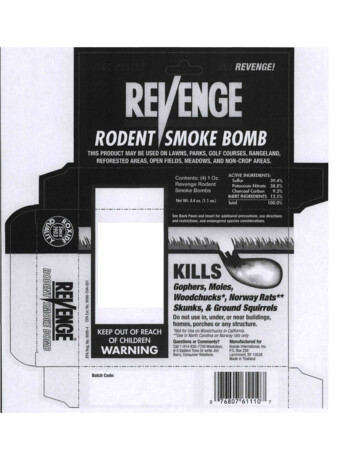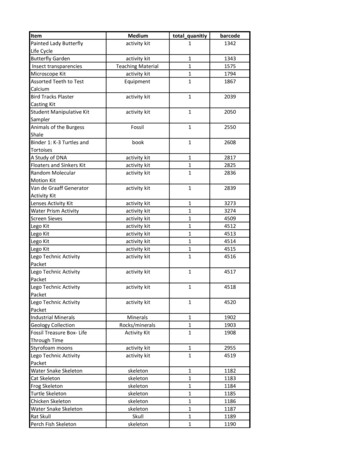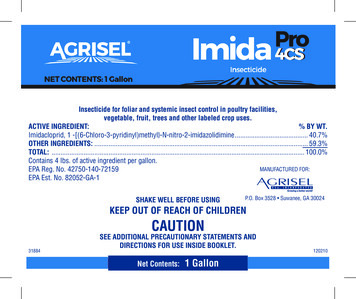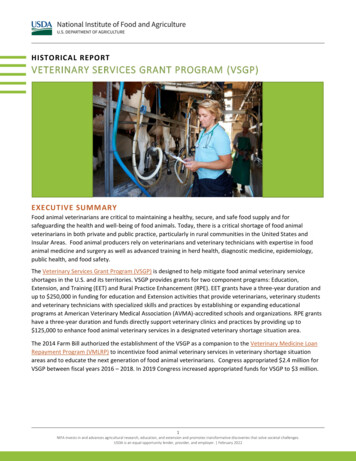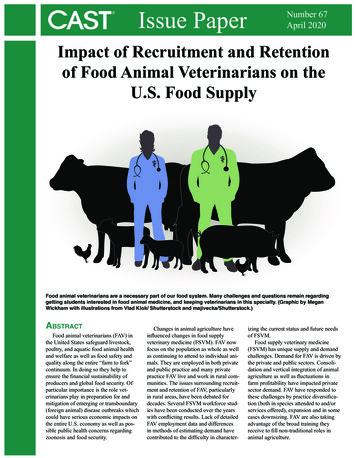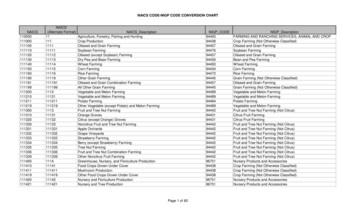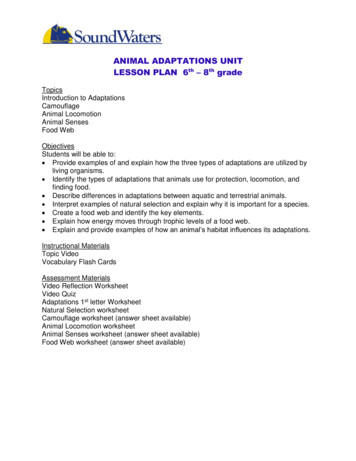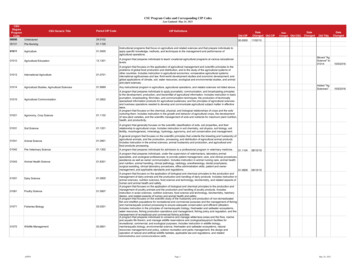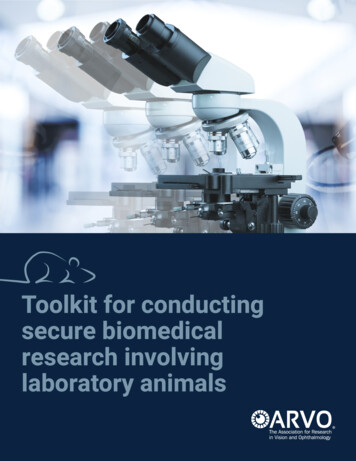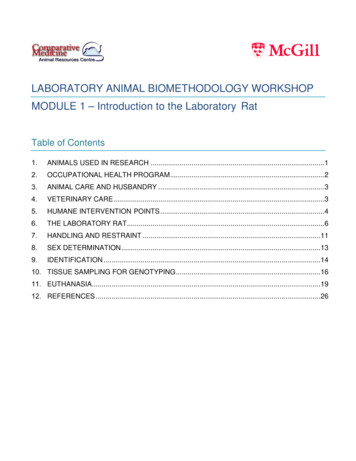
Transcription
1Food Animal Veterinarians: An Endangered Species?College of Veterinary MedicineContinuing EducationKansas State UniversityManhattan, KansasOctober 25 & 26, 2002Are Too Few Veterinary Graduates Choosing Food Animal Practice?What is the Problem?Otto M. Radostits, DVM, MS, Dip. ACVIMProfessor EmeritusDepartment Large Animal Clinical SciencesWestern College of Veterinary MedicineUniversity of SaskatchewanSaskatoon, SaskatchewanTele: 306-966-7153Fax: 306-966-7159E-mail: Otto.Radostits@usask.caIntroductionAre too few veterinary graduates choosing food animal practice? What is theproblem? The answers to these questions are multidimensional and requireconsideration of relevant background of veterinary demographics, veterinaryeducation, veterinary students, animal agriculture, private and public food animalpractice, veterinary licensing systems, and changes which have occurred, or notoccurred, in the last few decades. The problem is not confined to the number ofveterinary graduates choosing food animal practice; it is much larger. The major shiftin orientation of veterinary students towards small animal practice and away fromother important sectors of veterinary medicine is a concern.We are living in a time of rapid social, political, economic, and technologicchange. Many of these changes are profoundly altering the veterinary profession andthe kind of services that the public requires from veterinarians. A consideration ofveterinary history reveals that when veterinary colleges educated veterinarians toaddress important contemporary needs of society, the profession flourished, but whenthey have not, veterinarians were held in low esteem and the profession andveterinary education were neglected (Pritchard 1993). In 1998, it was said, The timeis opportune to change the focus of the veterinary medical profession from animal
2disease to animal health in all its dimensions (Pritchard 1988).It is remarkable how veterinary colleges and the profession worldwide arefacing similar questions about their future at the same time. Colleges are changingtheir curricula, licensing authorities are considering changes in the requirements forlicensure to practice, and the demographics of veterinary students have changed.Forty years ago students had similar backgrounds and a mixed animal practiceoutlook, while today students are more diversified and have specific professionalgoals.Historically, the political justification for the establishment and maintenance ofveterinary colleges was animal agriculture. The 31 veterinary colleges in NorthAmerica were established primarily to educate veterinarians to serve animalagriculture. Many practitioners reminded us that most of the colleges were founded aspart of the land grant universties under the Morrill Act of 1862. Originally theseuniversities started as agricultural and technical schools. What about the terms ofreference of the veterinary colleges now? Who should be concerned?In this paper, I briefly summarize several studies of veterinary education andthe profession published in the last 14 years, followed by a review of veterinaryemployment information, before addressing the question about too few graduateschoosing food animal veterinary medicine as careers, and some potential solutions.Reports on Veterinary Education and the Profession Last 15 YearsSeveral reports on veterinary education and the profession have beenpublished in the last 15 years which focus on similar themes about the state andfuture of the veterinary profession. They are important to consider in any discussion ofthe future of food animal veterinary medicine.PEW Report. In 1988, the PEW Report on Future Directions for Veterinary Medicinedescribed the history of veterinary medicine, its successes and what needed to bedone to meet the needs of society (Pritchard 1988).Its recommendation included:1. Change the focus of the veterinary medical profession from animal disease toanimal health in all its dimensions.2. Abandon the unrealistic concept of the universal veterinarian who can minister tothe health needs of all creatures great and small.3. Restructure veterinary practice to better serve the needs of society and theveterianry profession in the future.4. Make research a higher priority for individual veterinarians, the veterinary medicalprofession, and for veteri nary medical Colleges.5. Establish a more rational system of funding for veterinary medical research.6. Improve the quality of veterinary services delivered to all species of animals inresponse to the escalating expectations of the public as to the health of all animalsimportant to people.
37. Strengthen the general education of veterinarians.8. Focus the education process and the practice of veterinary medicine on the abilityto find and use information rather than on the accumulation of facts.9. Strengthen the basic biological science of the veterinary medical curriculum.10. Make the achievement of educational, experiential, and cultural, racial and ethnicdiversity among veterinarians a goal of veterinary education.11. Reorient clinical veterinary education to enable a student to elect in-depthinstruction and clinical experience with a practice theme (class of animals or a singlespecies), rather than require all students to obtain clinical experience with numerousspecies.12. Change the emphasis in the veterinary curriculum from almost total concentrationon clinical practice to include important public sector needs for veterinarians.13. Move towards a national perspective or strategy of veterinary medical education.The U. S. Livestock Market for Veterinary Medical Services and Products (1995)indicated that The fundamental task for food animal veterinarians is to shiftfrom a fee-for-service or task oriented business relationship to to fee-for-adviceor information oriented business relationship that is focused on the financialperformance of the livestock enterprise .If the food animal practitioner desires more income compared to otheropportunities, then they will have to increase the value of their veterinary services.This means that veterinary services must account for a greater part of the costs oflivestock production than they have been in the past. This means that routine tasksmust be done by veterinary technicians at a lower cost to the producer.AVMA-KPMG Report. In 1999, the KPMG Report sponsored by the AmericanVeterinary Medical Association, the American Animal Hospital Association, and theAmerican Association of Veterinary Medical Colleges focused on economic andlifestyle issues (Brown & Silverman 1999). Questions posed, including the adequacyof veterinarians incomes, the effect of women in the profession, the global demand forveterinary services, the inefficiency of the delivery system, the supply of graduates,and the skills, knowledge, attitude, and aptitude of veterinary students andveterinarians.CVMA Report. In 1998, a Task Force of the Canadian Veterinary Medical Associationpublished a report on the Future of the Veterinary Profession in Canada, VeterinaryMedicine in Canada: Opportunity for Renewal (CVMA 1998).Concerns included the lack of diversity of graduates, a potential surplus ofveterinarians trained for clinical practice and a deficit of veterinarians for many nonpractice activities such as food safety and environmental veterinary medicine. Thehigh percentage of women entering the profession, and the excessively highacademic entry prerequisite were concerns because there is no data to suggest thatacademically superior students become better veterinarians. Also, the high
4percentage of veterinary students who choose small animal practice after graduationmay cause an oversupply of small animal practitioners.Three issues in veterinary education were identified which requiredimmediate attention for the veterinary profession to remain relevant in the 21st century;the changing curriculum and making it relevant to societal changes; postDVM/retraining programs and continuing veterinary education and veterinaryextension; and recognition and rewarding of good teaching. In 1997, a CVMAmembership survey on limited licensure and undergraduate clinical tracking, amajority of Canadian veterinarians did not support either limited licensure or tracking;69% and 60%, respectively. Yet the Canadian veterinary colleges were beingcriticized for not providing enough specialization or specialty clinic rotations andcertain segments of society and business were demanding that veterinarians behighly skilled in specialized areas. The Task Force stated that our veterinary collegesmust educate generalists but simultaneously provide exposure in specialized areasfor interested students.To enable students to acquire increased practical expertise, it wasrecommended that the core vurriculum be confined to the first 3 years. The final 12months should consist of college rotations, paid practice externships, and approvedelectives of the students choice, which may include exposure to research, industry,government, and other non-practice environments.To solve many of the problems facing the profession, it was suggested thatselective, specific and short term post-graduate DVM programs encompassing bothclinical exposure opportunities such as internships and graduate degrees should beencouraged. Time spent in post-DVM education in whatever form is more productiveand efficient than an equal time spent in pre-veterinary education. Graduateeducation is an essential component of veterinary colleges, and is another way ofraising the level of the DVM to meet consumer expectations or societal relevance.These programs could also be used to upgrade practitioners wishing to update orenhance their skills in one specific field of veterinary medicine or to make careerchanges.The report called for a National Action Plan to fullfil the common vision of theprofession in Canada, namely: The profession will be composed of carefullyselected and educated veterinarians, providing optimal animal health to servethe needs of society while achieving professional growth and personalfulfilment.RCVS Consultation Document. Veterinary Education and Training: A Frameworkfor 2010 and Beyond. Veterinary surgeons in the UK were consulted about theeducation needs of the profession from 2010 to 2020 (RCVS 2001). A strategic reviewof the education and training needs of the profession was done to ensure that theCollege s policy on undergraduate provision, continuing professional developmentand postgraduate training adequately reflected the anticipated future needs of theprofession. The terms of reference were to undertake a review of the key issues
5facing education and training in the veterinary profession, and to formulate a drafteducation strategy for the College to meet those challenges over the next ten years,taking into account the fol lowing areas:"""""the need to confirm the College s definition of threshold standards ofprofessional competence;the role of employers and practices in the education and training of newveterinarians;whether registration should continue to be life-long (reaccreditation/revalidation) and the likely impact of any changes in policy on theeducation system;the College s future policy on continuing professional development;the role of postgraduate certificates and diplomas.Undergraduate tracking was not supported based on the belief that there isconsiderable value in retaining the breadth of the current veterinary degree with itsopportunities for comparative study across the species. Most schools in the U. K.have introduced a core-elective curriculum plus electives, and have rationalizedcourse content, freeing up time previously spent on didactic teaching in favor ofproblem-based and self-directed approaches to learning. It was concluded that thefollowing broad principles should be retained:"the veterinary degree course should continue to provide a broad, vocationallydirected, science-based education sufficient to prepare graduates for lifelongdevelopment within their veteri nary careers."the primary concerns of the course should continue to be the well-being ofanimals and the protection of public health"the degree should cover clinical training across all common, domestic speciesat the level of threshold (Day 1) competencies, but allow some choice foradditional study in mixed practice, individual species, or disciplines withinelectives."generic clinical skills, such as history taking, problem solving, sample/datacollection and evaluation and communication skills, must be emphasized, and"in order that students understand the context in which they are learning from anearly stage in the course, extra-mural studies should continue to play anessential role in the education of undergraduates.Extra-mural studies or rotations in veterinary practices or other areas ofveterinary activity such veterinary public health, diagnostic laboratories, researchlaboratories and government offices are considered a successful part of the clinicaleducation of veterinary students in the U.K. Only practices and other institutionswhich attain certain standards should be recognized by the schools and the RoyalCollege as appropri ate places for extra-mural teaching. There are two distinctcomponents: animal husbandry extra-mural rotations are done in first and secondyear, and the clinical extra-mural studies in the clinical years.
6Essential Competencies. The RCVS drafted guidelines on the essentialcompetencies of the new veterinary graduate (Day One Skills). The specification ofDay 1 competencies is, by implication, the starting point for continuing education andtraining, and continuing professional development.The Professional Training Phase. A professional training phase leading to alicence to practice in a specific veterinary area, would build on the educational baseprovided by the undergraduate curriculum. This phase would be undertaken indefined areas, in practices registered for that area, such as companion animals,production animals, equine, mixed practice or meat and food safety. Only satisfactorycompletion of the professional training phase would lead to granting a license topractice. The professional training phase could also be taken in a non-practiceenvironment such as state veterinary medicine.Effective June 2002, the Royal College of Veterinary Surgeons began Stage 1of a Pilot Study to test the validity and usefulness of Year 1 competencies and skillslist (RCVS 2002b). Ten new graduates from each of the six veterinary schools willparticipate in the study. Stage 2 of the Pilot study, from 2003, will involve a similarsized group of new graduates, and will test out the feasibility of the professionaltraining phase from the perspective both of the graduates and their employingpractices, following their progress for two years.CVMA Task Force on Education, Licensing, and The Expanding Scope ofVeterinary Practice. (Prescott et al. 2002)The CVMA Task Force on Education, Licensing, and the Expanding Scope ofVeterinary Practice in its opening statement said Concern has been expressedthat the relatively narrow and inflexible education and licensing system limitsthe development of the veterinary profession . (Prescott et al. 2002).In defining the problem facing veterinary medical education and licensing theCVMA Task Force said:From the perspective of the future of the veterinary profession, small animalpractice has come to dominate veterinary medicine at the expense of other importantveterinary needs. There is a shortage of veterinarians entering non-companion animalpractice fields that used to be well served by veterinarians (food animal practice,veterinary public health) and important areas of potential growth including biomedicalresearch and ecosystem health. However, to view the veterinary profession only as adichotomy does an injustice to the broad range of veterinary practice in differentanimal species and non-practice areas of the profession, all of which have becomeand will continue to become increasingly specialized and complex.There is no reason to think that the major trends observed over the last40 years will not continue into the future. Has the time come to recognize thisand to move in a formal way to a new stage in the evolution of the veterinaryprofession?Strengths and Weaknesses of the Current Veterinary Education and Licensing
7SystemThe strengths and weaknesses of the current veterinary education andlicensing system have been described the Canadian Veterinary Medical AssociationTask Force on Education, Licensing, and the Expanding Scope of VeterinaryPractice (Prescott et al. 2002)A. Veterinary education systemStrengths:"It attracts intelligent, well educated and highly motivated students to theprofession and provides a broad ranging education which exposes students toa wide range of topics."There is a strong comparative medicine base, so that students can extrapolateacross species."The faculty are dedicated, highly qualified and work in publically fundedinstitutions with strong academic bases."There is the opportunity to learn entry level clinical skills in many areas."Graduates have the flexibility to practice in diverse areas, and to changepractice areas without restriction by the licensing system. In addition, there is acommon standard, since graduates must pass the common North AmericanVeterinary Licensing Examination (NAVLE).Weaknesses:"The vast amounts of material to be covered, which is largely aimed at thegeneralist veterinarian, with great breadth but perhaps little true depth.Mastering this increasing volume of material is very hard on students, and isgetting harder every year."The generalist paradigm of veterinary education may waste clinical resourcesas well as student s intellectual capacity and potential. It is difficult to addanything extra to a packed curriculum, so that new topics or understanding areundeveloped."Many new graduates are under-confident and tend to go into small animalpractice, perhaps partly because this is the option they most readilyunderstand, but also because the majority of students intended anyway topractice small animal medicine when they entered veterinary Colleges."There is a distinct lack of interest by many students in certain areas, notablyfood animals. The current system serves agriculture poorly: there may be aninadequate caseload in food animals, partly because of biosecurity issues,most students have no background in agriculture, and students who do may notbe encouraged as much as they could be."A packed curriculum aimed at the generalist veterinarian does not encouragedeveloping the existing or potential diversity of the profession. The packedcurriculum may also result in students having a narrow conception of what aveterinarian is or could become, since many students operate at the managingto-survive level.
8""Other problems are that veterinary teaching hospitals are focused on tertiarycare and externship programs are relatively short. In addition, evaluation ofclinical performance of students in their final year is difficult and unreliable.There is no formal, required, internship after graduation. High student debt loadand high starting salaries in practice in fact may discourage further education,although statistics on recent graduates in the United States suggests thatentry level competence concern may in fact exceed concern about high debtload. High student debt load discourages adding an extra year to the program.A fifth year has in fact recently been added to the program at the Faculté deMédecine Vétérinaire in St Hyacinthe, although this reflects unique features ofthe pre-university CEGEP system in Québec.In summary, the explosion of knowledge, the increasing complexity andstandards of the different groups served by veterinary medicine, the changing natureof employment opportunities for veterinarians, and the increasingly high costs ofeducation for students make education of the universal or generalist veterinarian forexisting needs extremely difficult. In addition, the very wide but low (in terms ofdepth) door through which all graduates now enter may inhibit the profession fromtaking advantage of the expanding opportunities for the profession to better servesociety in fields such as public and ecosystem health.B. Veterinary licensing systemStrengths:"The integration of Canadian and United States systems through the NAVLE."There is flexibility for veterinarians to practice in diverse areas, and to changepractice areas without restriction by a licensing system.Weaknesses:"Licensing bodies lack the resources to conduct evidence-based evaluation ofthe competence of new graduates or for competency-assurance. They havedevolved the responsibilities for assuring entry-level competence to theColleges. The DVM degree is a general license to practice in whichcompetency issues are addressed through the complaints process and whichrelies on practitioners to confine their practice activities to the areas in whichthey are competent."The licensing system is largely run provinci ally by practitioners, whichinevitably maintains the status quo."There is no on-going re-certification program and the current licensing systemdoes not recognize special training or skills unless an individual is Boardcertified.Summary of Reports on Veterinary Education and the ProfessionThe important findings of these reports are:
9""""""""""""""Veterinary medicine has a public responsibility to serve the needs of societyVeterinary students and new graduates are not participating in the broad scopeand diverse sectors of the profession. There has been a major shift of studentinterest to small animal practice and away from non-companion animalveterinary medical careersAnimal agriculture is not being well served by veterinary medicine because of adeclining student interest and inadequate numbers of highly qualifiedveterinarians in all aspects of food animal veterinary education.In the recruitment of students there is an excessive emphasis on highacademic records at expense of other attributes considered necessary to be asuccessful veterinarianBecause of the massive increase in knowledge, the overcrowded curriculum,and the many clinical skills to be acquired, students find it impossible to learnand become competent and confident at graduation. The generalist paradigmof the curriculum is unsatisfactory.There are concerns about the skills, knowledge, attitudes and aptitudes ofveterinary students and new graduates.The undergraduate curriculum needs to be changed to allow a core curriculumin first two to three years, and an in-depth clinical experience in a practicetheme in the private or public sector in fourth year (variations of sreaming ortracking in fourth year). An objective should be the achievement of essentialcompetencies on graduation (Day 1)Extramural studies or practitioner externships are will become important and anecessary part of the education of veterinary students.The consequences on the profession of the high percentage (75 to 90%) ofwomen entering profession are uncertain. Females work part time and do notwant to invest financially in private practices. The future of private practice isnow a concern.Postgraduate professional training phase (Mandatory internship) andcompetencies at the end of Year 1 may be desirableRecognition of the importance and rewarding of good teachingToo few veterinarians engaged in research careers. Insufficient high qualityresearch. Failure of veterinary colleges to expose students to research careers.Importance of postgraduate continuing education and lifelong learningThe income of veterinarians is inadequateEmployment of Veterinarians in United States, Canada, United Kingdom andAustraliaUnited StatesIn the United States in 2001, of those veterinarians in private clinical practice(75% of total), approximately 74% were engaged in small animals, 8% in mixed
10animals, 4% in large animal exclusive, 6.9% in large animal predominant, 4.5% inequine practice; and other activities accounted for 3.5%.In 2001, veterinarians in public and corporate veterinary medicine, collegesand universities accounted for 46%, federal government 7.7%, state or localgovernment 6.3%, uniformed services 5.3%, industrial 17%, and other 17%.In 2000 and 2001, approximately 50 to 55% of new graduates entered smallanimal practice, 10% mixed animal practice, 5 to 6% large animal practice, 2 to 3%equine practice, 23% took advanced studies mostly internships, and 4% enteredother activities including governmental veterinary service, industrial veterinarymedicine and military veterinary medicine. It is clear that the majority of newgraduates entered small animal practice and the percentage continues to increaseannually.CanadaIn Canada, in 2002, of veterinarians in private clinical practice (78% of total),55% were in small animal, 29% in mixed animal, and 14% in large animal practice.Demographic Survey of Veterinarians in Ontario. In a survey of veterinarians inOntario in 2002, it was shown that the number of large animal veterinarians inOntario has been decreasing, attributable to two factors (Osborne 2002). First, thereis a natural migration from large animal practice throughout the career of aveterinarian. One-half of the veterinarians who began their careers in large animalpractice leave after the first year of practice, and another 10 percent leave within thenext five years. For the next 30 years, there is status quo. That is to say, "If you cansurvive the first five years, you will stay for 30." The number one reason for leavinglarge animal practice was being on call too much. The second most important issuewas inadequate salary, followed by working conditions and then health problems. Aredistribution of work away from large animal practice and toward small animalpractice was the fifth most important reason cited. The second factor contributing to adeclining number of large animal veterinarians is a declining interest in large animalmedicine. Since the 1950s, there has been a clear trend away from large animalpractice. In the fifties and sixties, more than 70 percent of veterinarians practicedlarge animal medicine at some point in their career. This started to fall off in theseventies, and has fallen to 40 percent. The combination of declining interestcoupled with a natural migration away from large animal practice has created fewerlarge animal veterinarians today then there were yesterday.United KingdomIn the U. K. in 2002, 73.5% of time spent in general practice was in smallanimals, 8.4% in equine practice, 7.5% in cattle, 1.3% in sheep, 0.4 % in swine, 0.2%in poultry, 1.0% in exotic animals, 1.1% in meat hygiene, 0.1% in fish, 2.7% inlicensed veterinary investigation, 3% in practice management, and 0.4% in otheractivities (RCVS 2002a)
11AustraliaIn 2001, the average amount of time devoted to each species on a nationallevel was: dogs 50%, cats 28%, horses 10%, cattle 10%, sheep 1%, pigs 1%, poultry 1% and other species 3% (Heath & Niethe 2002).Almost all private practitioners reported spending some time on dogs and cats,but more than half did no work at all with the other species listed. For example, 51%did no work with horses and another 31% spent no more than 10%; only 11% ofprivate practitioners reported spending more than 20% of their time with horses. Thesituation was similar for cattle: 58% did no work and another 23% 10% or less of theirtime with them. Only 14% reported spending more than 20% of their time with cattle.In the case of sheep, 81% did no work and only 1% spent more than 10% of their timewith sheep. Less than 10% did any work with pigs or with poultry, and less than 1%spent more than 10% of their time with them.In the cities, 54% of time was spent on dogs and 35% on cats, but in countrytowns those percentages were 41% and 22%.There was also a difference between male and female practitioners in countrytowns. Whereas the average male spent an average of 54% of his time on dogs andcats, the percentage for females was 79%. There was little difference between malesand females in the cities, except that males on average reported spending more timewith horses than did females.In summary, services being offered by the veterinary profession acrossAustralia are increasingly being focused on the pet-owning community. These trendsare occurring not only in urban centers but also throughout rural and regionalAustralia. These findings, together with the shift in gender balance, clearly indicatethat the profession is undergoing change on a scale never experienced before andprobably unparalleled in any other profession. These changes present majorchallenges for those responsible for making decisions which will influence the futureof veterinarians in the Australian community.Survey of Veterinary Students in United States 2002Upcoming third and fourth year veterinary students in 27 U. S. veterinarycolleges in 2002 were asked if they anticipated making a career in food animalpractice (Wren 2002). The responses were varied and ranged from 2% to 40% ofstudents expressing an interest in food animal practice or mixed animal practice.Considering all colleges, only an average of 10 to 15% of students are interested infood animal practice as career. However, at Kansas State, 25% of the graduates of2001 accepted positions with a food animal component. For some colleges, less than10 students of classes of 80 to 100 students expressed an interest in food animalpractice as a career.The situation is similar at every veterinary school. People still want to beveterinarians, but the face of student body has changed. There are more womenstudents in veterinary schools (often outnumbering male students), and thereis a dramatic reduction in students wanting to pursue food animal medicine.
12This is causing a crisis in the food animal medicine world. Who will be the bovine andother food animal practitioners of the future? W ho will take over for those
4 percentage of veterinary students who choose small animal practice after graduation may cause an oversupply of small animal practitioners. Three issues in veterinary education were identified which required immediate attention for the veterinary profession to remain relevant in the 21st century; the changing curriculum and making it relevant to societal changes; post-
